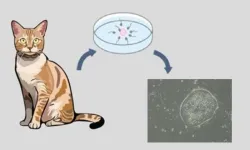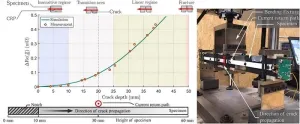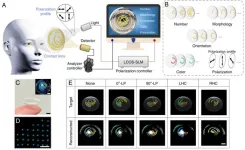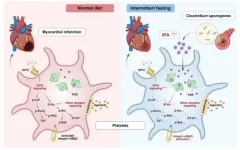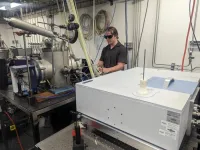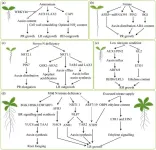(Press-News.org) The following is a Q&A with Dr Nerea Casal García, a sports scientist focusing on sports training and performance optimization. To speak to the author, or to receive an advance copy of the paper, please write to: press@frontiersin.org The paper will be published on 27 Feb 2025 06:15 CET]
Dr Nerea Casal García is an athlete, personal coach, and injury readaptation specialist who last year completed a PhD on observational analysis in elite sports. Today, she is a professor at the Institut Nacional d'Educació Física de Catalunya of the University of Lleida, focusing on the theory and practice of training and performance optimization.
Casal García is the corresponding author on a new study in Frontiers in Sports and Active Living, which revealed major shift over the past five years in the stride patterns of female elite athletes during 400 meter hurdle competitions – a change that went together with a marked improvement in performance. Here, she answers our questions about her research and career as an sportswoman, coach, and scientist.
What inspired you to become a researcher?
In my case, curiosity played the most significant role. During my years studying sports sciences, I constantly wondered how different training methods might work or how to optimize the performance of the athletes I coached. Moreover, I have always enjoyed teaching, so the opportunity to combine research and education led me to pursue an academic career after completing my master's degree. Having always practiced athletics, I became increasingly aware, through my experience as a coach, of the gaps in training information that could benefit both coaches and athletes. This realization ultimately inspired me to focus on research in this field.
Can you tell us about the research you’re currently working on?
I am currently continuing my work in performance analysis in athletics. Specifically, along with my research group, I conduct biomechanical analyses in high-level competitions. At the same time, I combine this with new projects aimed at studying the different athlete profiles and identifying the key variables that determine performance in various events. We hope that these projects can provide valuable insights on how to tailor athlete training based on their individual characteristics.
In your opinion, why is your research important?
In sports, every athlete strives for maximum performance, dedicating countless hours to achieving even the slightest improvement. This is why coaches seek ways to optimize performance within the available time and conditions. To enhance performance as efficiently as possible, it is essential to conduct studies on different events to understand which variables are key to performance and which methods or techniques may be most effective. At the same time, such research allows us to explain individual variability in athletes’ performances. I believe that the research we conduct is crucial for supporting coaches by providing valuable information and ensuring they have access to the most relevant data to enhance their athletes’ performance.
Are there any common misconceptions about this area of research? How would you address them?
I believe that results obtained from very specific samples, such as Olympic finalists, are sometimes overly generalized. While having as much information as possible is essential, it is equally important to recognize that individualization is a fundamental principle in sports training. At the same time, I believe this is a field that requires a high degree of applicability. Therefore, it is essential to produce scientific knowledge that is clearly applicable to the real-world context of performance and is easily understandable for coaches.
What are some of the areas of research you’d like to see tackled in the years ahead?
I believe that technology is advancing rapidly, and in the coming years, we will be able to obtain much more precise data on internal load and biomechanical variables. This will allow us to take research to the next level. I hope we will have a wealth of real-time information on athletes' performance in the near future.
How has open science benefited the reach and impact of your research?
Many sports coaches are not connected to the academic world, making it difficult for them to access this information, which is often used only by researchers. However, open-access research allows all coaches to access this knowledge, bridging the gap between academia and practical application.
END
Taking sports science in her stride: How Dr. Nerea Casal García aims to maximize performance on the track
2025-02-27
ELSE PRESS RELEASES FROM THIS DATE:
Pioneering work generates feline embryonic stem cells in boon for cats
2025-02-27
As different as they may seem, humans and cats have similar ailments, but in terms of health care, veterinary regenerative medicine is not as advanced.
A possible solution rests in embryonic stem cells, which can differentiate into various types of cells and be transplanted to restore internal damage. Further, they are characterized by their near-natural state similar to induced pluripotent stem (iPS) cells. Recent research has successfully generated feline iPS cells, but not embryonic stem cells, so research on these cell lines is essential to improve the quality ...
Decoding the link between colorectal cancer risk and steatotic liver disease
2025-02-27
Alcoholic and non-alcoholic fatty liver disease (NAFLD) are well-known risk factors for colorectal cancer (CRC). NAFLD has emerged as a heterogenous disease tightly linked to metabolic dysfunction and has been redefined under the umbrella term ‘steatotic liver disease’ (SLD). However, CRC risk variations across different SLD subgroups remain unknown. Now, researchers from Japan have discovered that the risk of CRC varies significantly among SLD subgroups, with patients with alcoholic liver disease being at higher risk.
Lifestyle-related disorders have become increasingly prevalent, representing a major health ...
Controlling conformational changes in protein aromatic side chains
2025-02-27
Novel protein cage system can control and visualize orientational changes in aromatic side chains upon ligand binding, as reported by researchers at Institute of Science Tokyo. By inducing coordinated molecular changes, this approach enables precise control over protein dynamics while also enhancing fluorescence properties. Their breakthrough could lead to applications in biomolecular robotics, drug delivery, and advancing the development of responsive biomaterials.
The dynamic nature of proteins—their ability to bend, fold, and change shape in response to their environment—underlies ...
Experimental and numerical analysis of the potential drop method for defects caused by dynamic loads
2025-02-27
In our paper “Experimental and Numerical Analysis of the Potential Drop Method for Defects Caused by Dynamic Loads”, we investigate how the electrodynamic proximity effect can be utilized to enhance the defect sensitivity of PDM in SHM applications by proper arrangement of the measurement setup. We showed how eddy current effects present in our PDM setup can be modeled analytically and numerically. Lock-in technique and the application of the skin effect allow high- resolution impedance ...
Chinese researchers make breakthrough in artificial chiral structural-color microdomes
2025-02-27
Chiral-structural-color materials produce color through microscopic structures that interact with light rather than through pigmentation or dyes. Some beetle exoskeletons, avian feathers, butterfly wings, and marine organisms feature these structures naturally, producing iridescent or polarization-dependent colors. Over the last 10–15 years, scientists have made progress in developing artificial chiral-structural-color materials.
Recently, Chinese researchers have made a breakthrough in the field by discovering that microdomes made from common polymers exhibit tunable chiral structural colors with broad-spectrum capabilities and multiple ...
Intermittent fasting inhibits platelet activation to reduce thrombosis risk
2025-02-27
Cardiovascular diseases remain a leading cause of death worldwide, with platelet hyperactivity and subsequent thrombosis playing a pivotal role in these conditions. While intermittent fasting has long been recognized for its metabolic benefits, including improvements in metabolic diseases, weight loss, and even lifespan extension, its effect on platelet activation and thrombosis formation remains less understood.
A recent study by Professor Junbo Ge team at Fudan University unveiled a novel mechanism by which intermittent fasting can significantly reduce the risk of platelet hyperactivity and thrombosis. That is, intermittent fasting elevates levels of the metabolite ...
A clear game-changer: Curtin’s water-repellent glass breaks new ground
2025-02-27
Curtin University researchers have developed a new technique to make glass water-repellent, a feature that could improve safety in vehicles, reduce cleaning costs for buildings and enhance filtration systems.
The research, published in the prestigious journal Advanced Functional Materials, shows how an innovative and non-toxic process using ultrasonic sound waves can alter the surface of glass, making it either hydrophobic (water resistant) or electrically charged.
Lead researcher Associate Professor Nadim Darwish, an ARC Future Fellow at Curtin’s ...
Are our refrigerants safe? The lingering questions about the chemicals keeping us cool
2025-02-27
A team of scientists at UNSW has discovered that some of the most important new refrigerants break down, in part, into persistent greenhouse gas pollutants, including compounds that have been banned internationally. Refrigerants are chemicals that turn from a liquid to a gas – and vice-versa – and transfer heat in the process, that are used for refrigeration and indoor heating and cooling. The chemicals are also used as aerosol propellants, fire retardants and in the manufacture of foamed plastics.
Hydrofluoroolefins (HFOs), which react rapidly in the lower atmosphere, have emerged as the lead synthetic chemical for refrigerants, and are considered a more environmentally friendly ...
How nitrogen reshapes root system architecture in plants?
2025-02-27
In soil, nitrogen (N), an essential macronutrient for plant growth, exhibits significant spatial heterogeneity. This necessitates plants to grapple with a complex array of environmental conditions in their quest for N sustenance. Roots, as the pivotal organs in N acquisition, manifest a remarkable morphological plasticity, including variations in the length and density of primary roots, lateral roots, and root hairs, in response to the form and content of available N, which is termed N-dependent root system architecture (RSA). For cultivated crops, the ...
‘Fluorescent phoenix’ discovered with persistence rivaling Marie Curie’s
2025-02-27
A research team at POSTECH (Pohang University of Science and Technology) has successfully developed a super-photostable organic dye after two years of dedicated research—demonstrating perseverance akin to that of Marie Curie, who painstakingly extracted just 0.1 grams of radium from eight tons of ore to earn her Nobel Prize.
Single-molecule imaging, a technique that uses fluorescent markers to track proteins with precision, plays a crucial role in cell biology, biochemistry, molecular biology, and drug discovery. However, conventional organic ...

